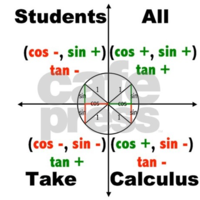You are using an out of date browser. It may not display this or other websites correctly.
You should upgrade or use an alternative browser.
You should upgrade or use an alternative browser.
i need solutions please
- Thread starter nessmell
- Start date
D
Deleted member 4993
Guest
Please show us what you have tried and exactly where you are stuck.View attachment 21839
in ]-π , 2π[
Please follow the rules of posting in this forum, as enunciated at:
Please share your work/thoughts about this problem.
i m sorry i m new here ... i don't know where to startPlease show us what you have tried and exactly where you are stuck.
Please follow the rules of posting in this forum, as enunciated at:
Please share your work/thoughts about this problem.
D
Deleted member 4993
Guest
Have you studied "unit circle"?i m sorry i m new here ... i don't know were to start
HallsofIvy
Elite Member
- Joined
- Jan 27, 2012
- Messages
- 7,760
What definition of "cosine" are you using? The standard "trigonometry" definition, "near side over hypotenuse", doesn't apply here because that is never negative. So you must have been given another definition in order to be able to do this problem, perhaps the "circular function" definition, https://www.mathplanet.com/education/algebra-2/trigonometry/circular-functions.
pka
Elite Member
- Joined
- Jan 29, 2005
- Messages
- 11,978
View attachment 21839
in ]-π , 2π[
Because of some confusion I looked HERE .What definition of "cosine" are you using? The standard "trigonometry" definition, "near side over hypotenuse", doesn't apply here because that is never negative. So you must have been given another definition in order to be able to do this problem, perhaps the "circular function" definition, https://www.mathplanet.com/education/algebra-2/trigonometry/circular-functions.
Have you studied "unit circle"?
yes
HallsofIvy
Elite Member
- Joined
- Jan 27, 2012
- Messages
- 7,760
Can you do the problem now? I presume you know that an "equilateral triangle" has a all sides the same length (let's call th\fat "s") and all angles the same measure (so 180/3= 60 degrees). The line from one vertex perpendicular to the opposite side bisects that side and bisects the angle- so it divides the equilateral triangle into two 30- 60- 90 right triangles. The hypotenuse of each of those right triangles is s while the side opposite the 30 degree angle is s/2. By the Pythagorean theorem, the side opposite the 60 degree triangle has length t that satisfies \(\displaystyle t^2+ (side/2)^2= s^2\) so \(\displaystyle t^2= s^2- (s/2)^2= s^2- s^2/4= s^2(1- 1/4)= s^2(3/4)\) so that \(\displaystyle t= \frac{\sqrt{3}}{2}s\). The side opposite the 60 degree angle (so next to the 30 degree angle) divided by the hypotenuse is \(\displaystyle \frac{\sqrt{3}}{2}\).
thank you ... we have -√3/2 not √3/2Can you do the problem now? I presume you know that an "equilateral triangle" has a all sides the same length (let's call th\fat "s") and all angles the same measure (so 180/3= 60 degrees). The line from one vertex perpendicular to the opposite side bisects that side and bisects the angle- so it divides the equilateral triangle into two 30- 60- 90 right triangles. The hypotenuse of each of those right triangles is s while the side opposite the 30 degree angle is s/2. By the Pythagorean theorem, the side opposite the 60 degree triangle has length t that satisfies \(\displaystyle t^2+ (side/2)^2= s^2\) so \(\displaystyle t^2= s^2- (s/2)^2= s^2- s^2/4= s^2(1- 1/4)= s^2(3/4)\) so that \(\displaystyle t= \frac{\sqrt{3}}{2}s\). The side opposite the 60 degree angle (so next to the 30 degree angle) divided by the hypotenuse is \(\displaystyle \frac{\sqrt{3}}{2}\).
D
Deleted member 4993
Guest
In which quadrant (I or II or III or IV), the value of "cosine" is negative (< 0)?
HallsofIvy
Elite Member
- Joined
- Jan 27, 2012
- Messages
- 7,760
Cute! So now you know, from post, from post #9. that cos(30)=√32cos(30)=32. Now you know that cosine is negative in the second and third quadrants. cos(180- 30)= -cos(30)


